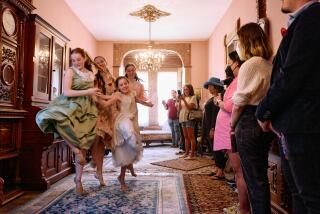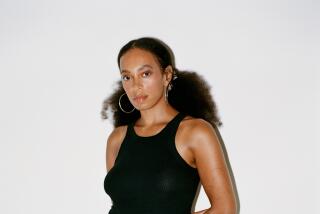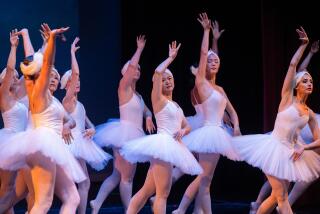A Dance With Difficulty
- Share via
Nobody in American dance has been closer than Sali Ann Kriegsman to all the power centers of the art, whether artistic, governmental or journalistic.
The executive director of the prestigious Jacob’s Pillow Dance Festival in Massachusetts (a festival founded by modern dance pioneer Ted Shawn), Kriegsman was from 1986 to 1995 the director of the dance program at the National Endowment for the Arts, the largest dance funder in the nation, with an average annual budget during her tenure of $8.2 million.
She has also taught and lectured on dance nationwide, written dance criticism and a book titled “Modern Dance in America: The Bennington Years,” and served as dance consultant to the Smithsonian Institution.
Born in New York City, Kriegsman, 60, lives in Maryland with her husband, Pulitzer Prize-winning dance critic emeritus of the Washington Post, Alan M. Kriegsman. This interview was done by phone from her office at the Pillow.
*
Question: What do you see as the big dance news of 1996?
*
Answer: For me the biggest story was the reduction in funding overall at the National Endowment for the Arts--the first year that it went down substantially to $99.5 million [from $162.3 million]. And although the impact of those cuts wasn’t felt in 1996, they will be felt in ’97 and ’98. And, psychologically, the disappearance of grants to individual choreographers [replaced by grants to institutions] will have major impact in the field. Those grants were one of the very few sources of unfettered support for creative development.
Q: Was this shift in funding a result of all the debate about the moral content of new work?
A: I don’t think there’s any question about that. I think the Congress was feeling extremely nervous about giving money to individuals.
The bottom line is we don’t know how to support the arts in this country, we haven’t figured it out. The censorship wars and other controversies have been a grand distraction from actually trying to put our heads together and figure out how to create a system of, you can call it patronage, subsidy, investment, that turns out to be beneficial to the society as a whole and to the artists working in that society. We haven’t done it.
Q: What do you see as the greatest problem for dance in 1997?
A: I think there are two. One is the financial infrastructure of being able to continue to do work at all levels--not just the individual artist in the studio, but artists in communities and in schools, major companies all over, touring.
The other problem is how to develop a better informed audience. We have a new program [at Jacob’s Pillow] predicated on the idea that there isn’t enough opportunity for people to learn about dance, even for people who are devoted dance-goers. I’m not talking about data now but about opening up a window on what they’re seeing onstage, the context in which work is being presented.
With the funding cutbacks, less touring, less dance on television, it’s not as easy as it used to be for people to see a lot of dance. So they see dance in a very isolated way, and they have no context in which to perceive it. I’ve found that they are thirsty for information--they really want to know more about dance and there are very few places for them to get that kind of information.
Q: What do you find particularly innovative at the moment?
A: I think Savion Glover in “Bring in ‘Da Noise, Bring in ‘Da Funk” is an immense breakthrough for tap and for dance. The whole tap renaissance is very exciting--to see Savion now becoming a mid-career artist with younger dancers that he has influenced coming up around him and others who are working very seriously with this medium. It’s an affirmation of dance’s ability to transcend tremendous cultural hardship and neglect.
I also think what [Mikhail] Baryshnikov has been doing with White Oak is very important. It’s artistically mature dancers taking chances on new choreographers, and bringing repertory that’s fresh to audiences that would never see it otherwise. I think this is incredibly educational in audience-building. The problem is there isn’t enough following in the wake of that. It becomes an isolated event.
There are also less visible things happening that are very exciting. Dance in community settings, for example. It’s been here, it’s not newly invented, but I think there’s a new commitment by a large number of artists to work creatively with different populations.
There’s going to be a festival in Boston of wheelchair dance, for example, and it’s not just that a handicapped population is being enriched by dance but that the choreographic process is being expanded by individuals who normally would not have been included. I see that happening with prison populations, new immigrants, children, abused women, probably even abused men: artists working with special populations in ways that enrich both the artist and the community.
Q: Talk to me about ballet. Has it been left behind, socially and artistically? What about racial diversity?
A: I think the level of dancing in ballet companies around the country is at an all-time high and the richness of repertory is also probably higher than ever because there is so much good work that has been shared, whether it’s Paul Taylor or George Balanchine or whomever. But the dearth of new choreography that is distinctive and important in the ballet world is still a major problem. And the cost of making that work is tremendous.
I think those companies that have their artistic noses in the future are looking at diversity on the stage, in terms of who’s dancing and who’s in their audiences. If you talk to someone like Bruce Marks at the Boston Ballet, he’s been devoted to changing the complexions on the stage because he believes the creative juice of the future will come from new voices and colors and they will have different things that they want to make dances about. It won’t be “Swan Lake,” it will be something else. And that’s very healthy.
I think that New York City Ballet and [American] Ballet Theatre have had very token representation of people of color in their ranks, and there are complex reasons for that. But I’ll just go right out on a limb and say it’s not been the highest priority for them and it has to become the highest priority.
Eliot Feld decided that his dancers were going to come from an all-scholarship, [racially diverse] New York City public school and that’s what he’s done. And there’s a culture now that’s growing up around his company that says to young people, “Ballet is an exciting thing to do and there are other people like you to do it with.” That’s very contagious.
But there are also economic factors to consider here. For a family that’s economically stressed or for a child who doesn’t even have a family, how does that child get into a ballet school--and what kind of future is there in terms of making a living? When you look at what dancers make, you have to wonder what anybody of any color is doing there.
(BEGIN TEXT OF INFOBOX / INFOGRAPHIC)
CROSSROADS
Through Saturday, the daily Calendar section will continue its series of interviews conducted by Times critics. The series follows Sunday Calendar’s comprehensive look at 1996.
TODAY
DANCE: Sali Ann Kriegsman.
FRIDAY
TELEVISION: Dick Wolf.
SATURDAY
ARCHITECTURE: Richard Meier.
More to Read
The biggest entertainment stories
Get our big stories about Hollywood, film, television, music, arts, culture and more right in your inbox as soon as they publish.
You may occasionally receive promotional content from the Los Angeles Times.










